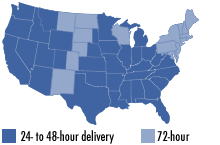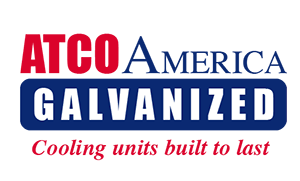Troubleshooting an RV Refrigerator
The cooling unit is the single most expensive part of a refrigerator to buy and install—you don’t want to buy a cooling unit you don’t need. We’ve remanufactured and sold more than 50,000 cooling units—so before you order a replacement, let our experience help you determine if a refrigerator’s cooling unit is defective.
- A. When you definitely need a new cooling unit:
The only certain indicators of a defective cooling unit are the presence of an ammonia smell or visible yellow powder (most often near the burner area). If either of these indicators is present, give us a call and we’ll get you a new unit right away. If neither of the indicators is present, we recommend you go through the troubleshooting checklist below before ordering a replacement unit.
- B. When you’re not sure you need a new cooling unit:
All the symptoms of poor performance, other than an ammonia smell, could be caused by problems other than a failing unit. The only way to determine if the unit is the source of the problem is to check all components per the manufacturer’s instructions, including the heating element and thermostat. For any test to be effective, three conditions must be met: 1) the unit must be level; 2) the unit must have the correct heat applied; and 3) the boiler/heating area must be insulated correctly.
1. Checking Level
The level of the cooling unit is important for correct operation because there is no pump/compressor to push the fluid and gasses through the system. Convection currents and gravity are the forces that make things move, and they’re relatively weak forces. If the unit isn’t level the fluids will build up in areas not intended or flow too fast in other areas. Either case will adversely affect the unit performance and could damage the chemical charge or the unit itself.
You can check the level whether the unit is in the refrigerator or is free-standing:
-
IF THE UNIT IS IN THE REFRIGERATOR: Place a two-way level in the freezer compartment. If the freezer tubes of the unit are visible in the freezer compartment, place the level on the tubes or the tray that covers the tubes. If the tubes are not visible in the freezer compartment, place the level directly on the floor of the freezer compartment. The freezer floor or tubes should be level both front to back and side to side.
-
IF THE UNIT IS FREE-STANDING: Lean the unit against the wall with the freezer tubes (the ones sticking out perpendicularly from the foam block) touching the wall. Some models require a wedge be placed under the foot of the unit to level the freezer tubes. Place a two-way level on the freezer tubes that stick out perpendicularly from the foam block. The unit should be level both front to back and side to side. If the unit you have doesn’t have freezer tubes that are perpendicular to the foam block, call ATCO America to get further instructions on how to check the level of the unit. (Please be prepared to tell us the make and model of the unit.)
-
All cooling units should have the Absorber Tubes (the set of tubes below the foam pack that spiral down to the tank) sloping equally. In other words, if you put a level on any of the front course (set) of tubes they will be the same degree out of level as any of the back course. It doesn’t matter how much out of level they are, just that the amount of slope is about equal. For example if the front course is 1/2 a bubble out of level the back course should be about 1/2 a bubble out of level too.
2. Checking for Correct Heat
For the unit to operate it needs a specific amount of heat to boil the liquid. If there is a problem with the delivery of the heat to the unit it will not perform as designed. The gas system is not used for this test because measuring the heat of a flame requires expensive equipment. The heat delivered from the 110-volt heating element can easily be measured, so it is used during cooling unit testing.
To check only the cooling unit’s performance, the heat to the unit must not be interrupted by the operation of the thermostat, so it is bypassed by applying power directly to the heating element. Do not leave a cooling unit unattended while running on bypass mode, due to fire hazard.
The best way to verify correct heat is to measure the amount of heat being applied by the element with an ampere clamp or meter. The ampere reading must be taken while the element is in operation. (The reading in amperes can be converted to watts using the table on the Heating Elements page of our Web site.) If the element is not running within 10% of its rated wattage, it should be replaced. Under some conditions, elements running below the 90% range can operate a unit, but operation will be affected as the limits of the refrigerator are reached in very hot or humid conditions. The resistance test, measuring ohms, is not a test of the element while in operation and does not give information as useful as the ampere reading.
3. Checking for Correct Insulation
Rather than using a very large heat source to operate the unit, the manufacturer uses a smaller heat source and insulates the boiler area to make full use of the energy input. All units must have a sheet metal enclosure around the boiler/generator area that is packed tightly with fiberglass insulation. If the insulation is missing, loose or damp, the proper heat won’t be applied to the unit. Replace any damaged insulation and add what is needed to pack the enclosure snugly from top to bottom. Be sure to leave the flue (chimney) tube open at both ends of the enclosure.
4. Checking Refrigerator Performance
With all three conditions (level, heat and insulation) satisfied, turn on the refrigerator and measure the unit’s cooling capacity.
With the unit in the refrigerator, put one thermometer in the freezer compartment and a second in the refrigerator section and close the doors. Wait, without opening the doors, for an hour or two and check the freezer compartment. If the temperature has not started to drop, your unit is defective and should be replaced. If the temperature is starting to drop, close the door and wait about six hours to let the box temperature stabilize. Do not open the door during this wait. These refrigerators are low- powered and won’t recover sufficiently to give an accurate test if the door is opened frequently. If after six hours the refrigerator and freezer temperatures are acceptable, your problems are not with the unit. If the temperatures are not acceptable you should check for other possible causes (poor door seal, failing insulation in the box, box liner separating from the insulation, etc.). If there are no other problems, the unit is probably defective and should be replaced.
ATCO America participates in developing training and best practices for refrigerator maintenance and repair via the RVDA Learning Center.
Rush Delivery of RV Refrigerator Cooling Units in 24 to 48 hours

With distribution warehouses located across the U.S.A., the ATCO America Galvanized cooling unit you need is just a day or two away. Repair your RV refrigerator faster, with quick delivery. We can deliver a superior ATCO product within 24 to 48 hours to most dealers throughout America. Find shipping info here
Note: All prices listed on this web site are cash discounted retail prices.


